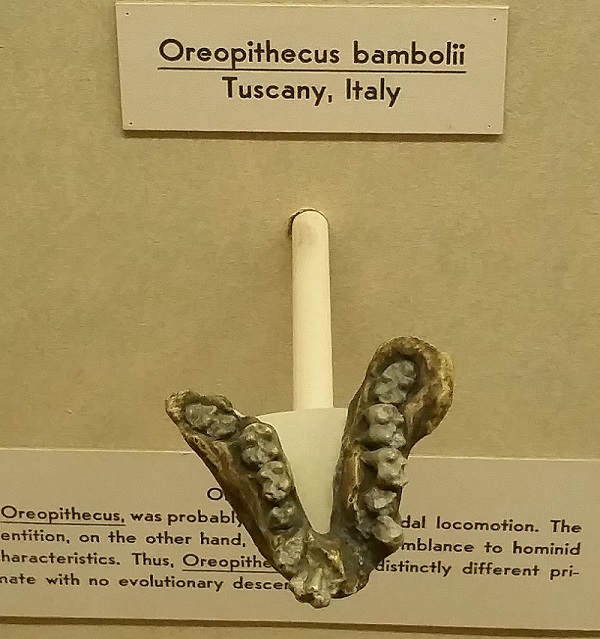Last week’s Fossil Friday specimen was, as I’m sure all of you could see, little more than a humble jaw. The question, of course, is whose jaw was it? Let’s take a look at the full picture:

This week, as I start to make some early preparations for Darwin’s birthday, I’ll reveal that we are dealing with an extinct hominoid from the Miocene epoch, Oreopithecus bambolii. When I see the word hominoid I think of human origins. I selected this specimen because here we’re dealing with an organism that is a hominoid and yet is not one of our ancestors—a branch a bit further off the tree. Many people I run into who are learning about human evolution do not realize that our primate cluster has had many offshoots since it emerged, that not all of them are directly related to each other, and that many hominoid species went extinct long ago.
Oreopithecus bambolii remains an enigmatic member of our extended family. As recently as 2013 there was considerable debate surrounding whether or not the species engaged in bipedal locomotion, as our own species is so very fond of doing. Although the pelvis of this animal is smaller than other apes and in some other ways similar to bipedal primates, recent analysis of the lower spine indicates that while it was capable of walking upright, it is not likely that it did so habitually. There is also considerable debate as to the abilities of Oreopithecus bambolii to use their hands. Some see evidence that this animal had the precise gripping skills necessary for many human-like fine motor actions, and there is fairly strong agreement that the species was agile compared to other great apes due to the structure of their semicircular canals.
But what was it like? What would it be like it see one of these creatures alive? Would we recognize a kinship, as many of us do with the extant great apes? If this unsuccessful offshoot of the family tree did walk upright, was agile, and did use their hands in the delicate and dextrous manner we can, think of what it would be like to encounter one. To see a living thing come quite close to possessing those characteristics we think of as so essential for the development of humanity, and know that this organism did not contribute to our species' rise. That our relationship regarding these derived characteristics is purely convergent. It would be nice, in some ways, to know that we are not necessarily so very special.
This week’s winner? Robert Dekko! Thanks for playing, and if you have fossils you’d like to share, please email me at schoerning @ ncse.com.

